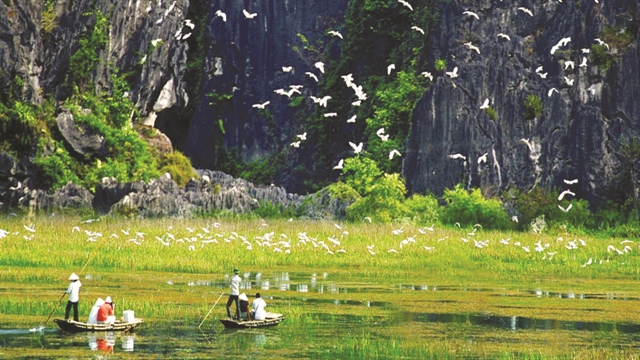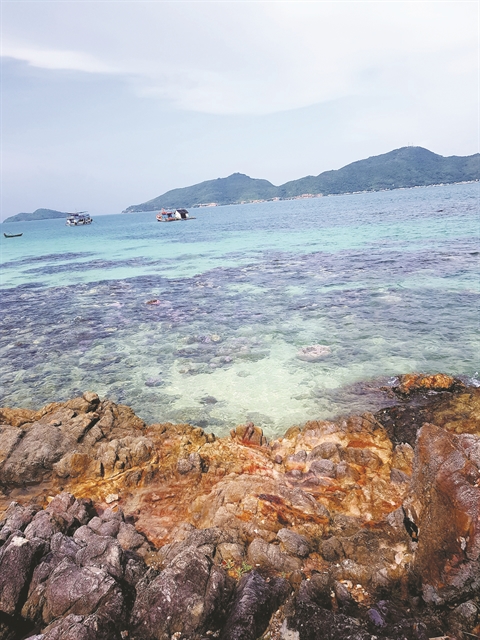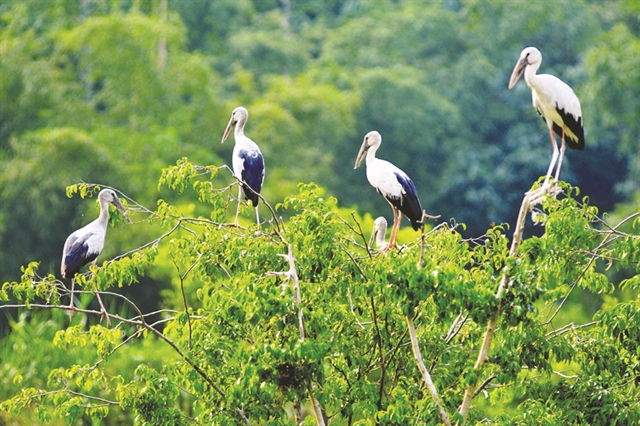 Features
Features

If you love nature, favour adventure trips, and are interested in Việt Nam's history, then Cà Mau Province in the Mekong Delta region is the place for you.

|
| Prime Minister Nguyễn Xuân Phúc attends the opening ceremony of the 2019 Cà Mau Culture and Tourism Week and the inauguration of the Hà Nội Flagpole in Cà Mau Cape. The PM and leaders of the Government and Cà Mau Province inaugurate the important cultural and historical project. VNA/VNS Photo Huỳnh Anh |
By Văn Châu
If you love nature, favour adventure trips, and are interested in Việt Nam's history, then Cà Mau Province in the Mekong Delta region is the place for you.
Often described as the "southernmost point of Việt Nam", the province is far more than just a reference point on a map.
Besides its great food, pristine air, and wetlands filled with birds, it's the only place in Việt Nam where you can see the sun rise over the East Sea and set over the West Sea.
Trình Viễn Tấn, a 50-year-old visitor from HCM City, likes it so much he comes for one week every year.
“I can fish, breathe the fresh air, try nice food, see a sunrise and sunset every day, and listen to the singing of hundreds of birds,” he says.
“Living and working in HCM City, I have to deal with air and noise pollution. But here, I always feel relaxed and recharged to go back to work.”

|
| FLOATING PARADISE: The U Minh Hạ National Park is located on a thick layer of peat, which causes the water to appear black. VNS Photo Văn Châu |
A place where humans and nature co-exist in harmony, Cà Mau is dotted with bird parks, wetlands, canals and forests.
The Năm Căn Forest area and U Minh National Park are two areas worth visiting.
U Minh, which refers to darkness, got its name because of the lack of sunlight caused by the density of trees. Even locals have found it difficult to navigate at times.
Separated by the rivers Trẹm and Cái Tàu, the park has two major areas called U Minh Thượng (Upper Park) in Kiên Giang Province and U Minh Hạ (Lower Park) in Cà Mau Province, just 25km from Cà Mau City.

|
| TRANQUIL: The southernmost province of Cà Mau has announced a plan to turn 1,300ha of the U Minh Hạ National Park into an eco-tourism zone by 2025. |
Every year, thousands of people visit the park for outdoor activities, including a climb up to a 24-metre high observatory where there is a panoramic view of the vast forests and waterways.
There are two types of forests in the province: mangrove and cajuput. The cajuput forest has the highest biological value among other types of natural forests because of its high economic and environmental value
Island life
Besides lush greenery, Cà Mau offers islands for those who want to just chill out on the beach, including Hòn Đá Bạc (Silver Rock), Hòn Khoai and Hòn Chuối.
Hòn Khoai, the biggest of the group, is a rocky island shaped like a potato (hence its name) that attracts tourists interested in seeing hills and forests with many kinds of precious wood.

|
| UNTOUCHED: Hòn Khoai Island attracts a number of tourists to its untouched beauty and peaceful charm. |
A path to the top of the island zigzags around the hillside and is shadowed by big, tall trees including jackfruit and mango as well as many century-old trees.
Various wild flowers blossom in rock cavities, while the sound of running water and chirping of birds, including wild geese and swallows, complete the serene scene. The algae found on the island's coast is used to cook delicious dishes.
After invading Việt Nam, the French colonialists built a system of lighthouses from Cần Giờ, Phú Quốc and Hòn Khoai to lead their ships.
On Hòn Khoai, the architecturally intact 318 metre-high lighthouse, pictured on many postcards, was one of the earliest construction sites in Vietnamese territorial waters.

|
| Built by the end of the 19th century during the French colonial time, the lighthouse is the highest peak of the Hòn Khoai Island, at altitude of 318 metres. VNS Photo Văn Châu |
In 1940, under the leadership of the Communist Party, local revolutionaries and residents launched an uprising and retook the administration in Hòn Khoai island from the French colonialists.
Another island that is attracting more travellers is Hòn Đá Bạc, one of the most splendid landscapes in Cà Mau.
In June, it was recognised as a national historical heritage site by the Ministry of Culture, Sports and Tourism.
The island is not only an ecotourism area endowed with fascinating scenery, but also home to marine creatures such as fishes, oysters, clams and shrimp.
Hòn Đá Bạc is located about 50 kilometres from Cà Mau City and spread over 6.4 hectares. Seen from afar, the island looks like a natural rock garden amid the immense sea.
The island has ancient trees and under their shade are countless shiny granite boulders. Some of the rocks have odd shapes that people have named, including Sân Tiên (Fairy Yard), Giếng Tiên (Fairy Well) and Bàn Chân Tiên (Fairy Foot).
Climbing the cliffs and slipping away into the groves, you can discover many secrets of nature.
Beginning in September, when the sea is the most beautiful with blue water and quiet waves, tourists can stroll the island or join the locals in catching squids or diving to find oysters in underwater caves.
For bird lovers, a 3.1ha garden located in the President Hồ Chí Minh monument area in Cà Mau City is a great place to view about 53 different species of birds.

|
| TOP SPOT: A bird garden in the Hồ Chí Minh Presidential Monument area in Cà Mau City in Cà Mau Province is popular with tourists. |
The garden has about 6,600 birds, and the number of wild birds can reach up to 10,000 or more during the peak reproductive season. Among the varieties you can see various kinds of herons, great egret, little cormorants, little egrets, and darters.
Established 20 years ago, the bird garden attracts about 30,000 visitors a year. To provide a better habitat for the birds, Cà Mau authorities are planting more trees, and are also setting up bird-watching towers for visitors.
With its many birds, forests and island beaches, Cà Mau Province deserves to be known for more than its overworn moniker "the country's southernmost point", though a trip to a lighthouse might be in order. VNS




